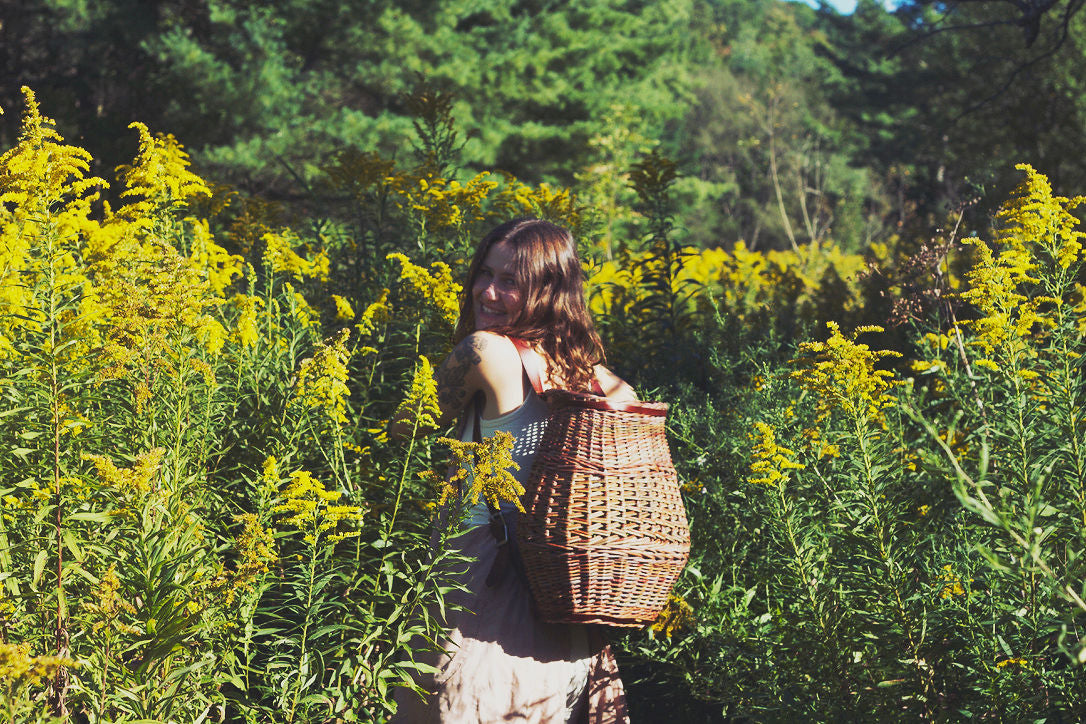Autumn is a great season to get started with botanical dyeing. The materials outside are abundant and you are probably pulling old sweaters out of storage for the change of season. Maybe they could use some botanical freshening up! I have a Botanical Dye 101 class on Skillshare & they recently interviewed me about my botanical dye practice. Here is what I had to say:

Skillshare: What are your favorite natural items or botanicals to use for dying fabrics?
Geraldine: One of my all time favorite dye recipes includes a combination of fresh Marigold & Goldenrod flowers.
SS: What’s the resulting color from those items?
G: The most vibrant golden orange. People stop and ask me about my outfit when I wear fabric I’ve dyed using the recipe I developed for those botanicals on linen or cotton.
SS: How did you get into botanical dying?
G: Botanical dyeing was a natural next step for me as an herbalist and gardener who loves color and custom clothing. I studied clinical herbalism with a focus on formulating, which means I have lots of experience brewing vats of botanically infused medicines and growing the plants needed for them. Growing and gathering plants to brew vats of color just made sense as a parallel skill to develop. Shout out to my friend, Sydney Hernandez, a skilled dyer who helped me get started and recommended key guide books that have influenced my process.
SS: Where or how do you source inspiration for the items you use as dyes?
G: I work with the palette of plants (and sometimes mushrooms!) right outside my door. I consider myself a bioregional herbalist and a bioregional botanical dyer. The practice of coaxing color from the fields, gardens, and forests surrounding my home teaches me what materials are abundantly available from season to season and which ones I should cultivate and conserve/not harvest. My bioregional botanical dye process mirrors the ecosystem around me and reminds me of my place in it.
SS: How has botanical dyeing helped you to personally live a more sustainable life?
G: When I get the itch to buy new clothing, I look through my closet first and see if there are any older pieces I can breathe new life into with botanical color. Often I can. This process has influenced me to buy less clothing and to search for light colored clothes comprised of natural fibers when I do shop. Clothing made from synthetic materials such as polyester don't take botanical color very well and also leach micro-plastics into our waterways every time we wash them. Double bummer! Synthetic colors are more toxic than I think most people realize. They pollute the waterways in the regions where clothes are made with them. Shopping for clothes made from natural fibers (such as cotton, linen, and hemp) that are un-dyed or lightly colored so you can extend their life later on is a good place to start. I often find clothing that checks these boxes at thrift stores and have them tailored for a better fit.
SS: How have you made your craft practice your own? In other words, what’s your distinctive take on botanical dyeing?
G: It would be easy to import botanical pigment from a larger company and get any shade I desire. In limiting myself to create color with just what I can find in my region (and sometimes my kitchen!), I have to get creative in order to create interesting and varied colors. I try to get as many colors from each dye pot as possible, using techniques such as shifting the pH to produce a new hue using ash from my wood stove or vinegar from my kitchen. My search for color in my bioregion has deepened my relationship with it and motivated me to get to know every plant and mushroom I come across. Not that these kin need to have a “use” to be of value, but it does pique my interest to know I might be able to brew a dye pot with a certain mushroom in the forest or flower from my garden. As a botanical dyer who came to the practice as a bioregional herbalist, I love knowing I am infusing each piece with not just color but the energetic medicine of the plants or mushrooms in the dye pot.
+++++++++++++++++++++++++++++++++++++++++++++++++++++
Since we are entering peak starting-a-new-craft-season, Skillshare is offering one month free with the coupon code ‘getcrafty’. Here is the link.


